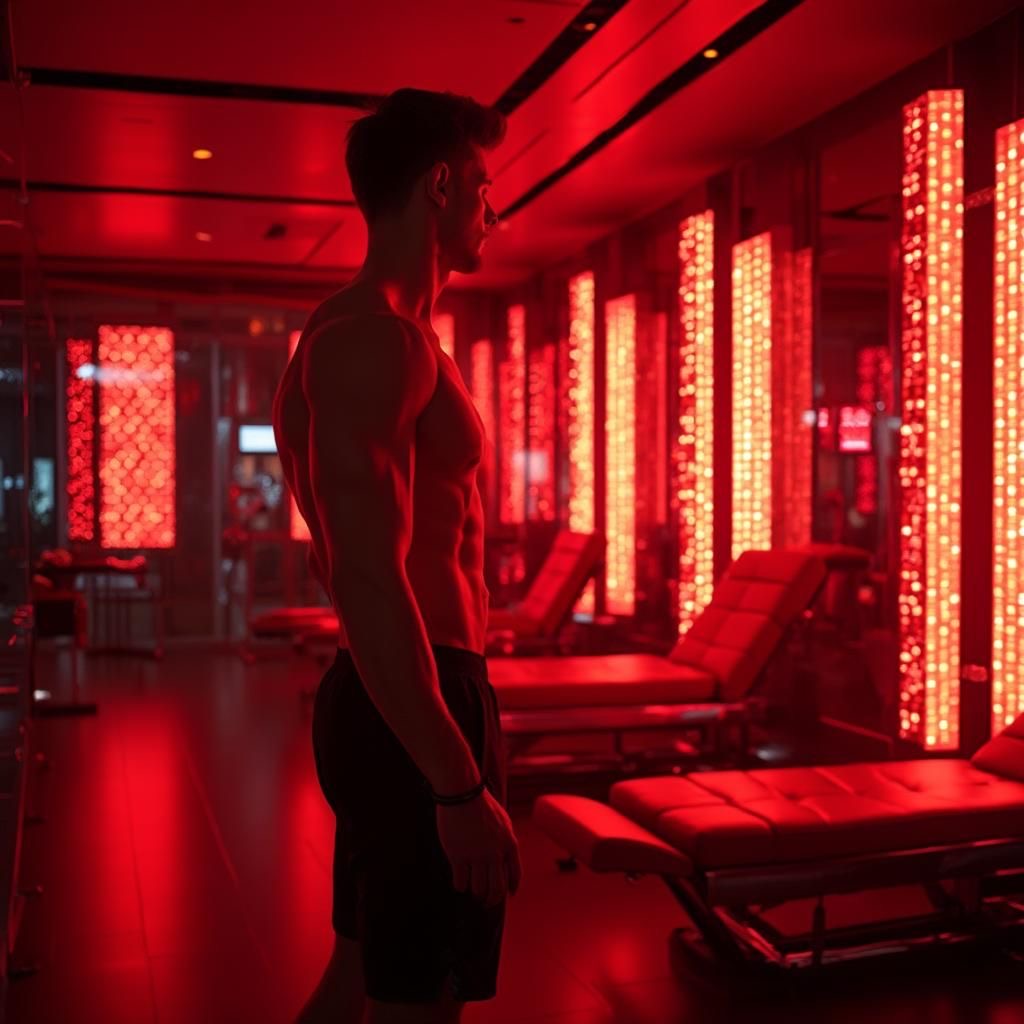Feeling zapped? Red Light Therapy at Home is the new buzz — from Red Light Therapy Panels to Red Light Therapy Beds, everyone’s glowing. Short answer? Anyone wanting better skin, less pain, or fuller hair is doing it. Stick around to find out who’s lighting up and why you should too!

Understanding Red Light Therapy (RLT)
What is Red Light Therapy?
Defining RLT: Low-Level Light Therapy (LLLT) and Photobiomodulation (PBM)
Red Light Therapy (RLT), also known as low-level light therapy or photobiomodulation, involves exposing the body to specific wavelengths of red or near-infrared light. It’s a non-invasive process used to enhance tissue repair, support skin rejuvenation, and improve cellular performance.
Unlike ultraviolet light, red light doesn’t burn the skin. It penetrates gently, stimulating natural biological processes.
How Red Light Therapy Works (Cellular Mechanisms, Mitochondria, ATP)
Red light reaches deep into the skin, targeting mitochondria—the energy centres inside your cells. This stimulation leads to an increase in ATP (adenosine triphosphate) production, which powers vital cellular functions.
With more energy available, cells can repair damage faster, reduce inflammation, and perform more efficiently.
A Brief History (NASA's Role, Evolution of Use)
NASA originally explored red light therapy to grow plants in space. Researchers discovered that red light also promoted tissue healing in astronauts—especially for wounds and muscle atrophy.
Since then, its use has expanded to skin care, sports recovery, and wellness routines worldwide.
Common Applications and Uses
Skin Health and Aesthetics
Red light therapy is widely used to improve skin clarity and texture. It helps reduce fine lines, boosts collagen production, and supports healing for acne, scars, rosacea, and sun damage.
Many users report a brighter, more even complexion after regular sessions.
Pain Management and Inflammation Reduction
Athletes and individuals with chronic pain often use RLT to reduce soreness and joint discomfort. The anti-inflammatory effects are thought to speed up recovery and relieve conditions like arthritis and tendinitis.
Red light can also help with stiffness by improving local blood flow.
Hair Growth and Restoration
Red light therapy is gaining traction among people with hair thinning or alopecia. It may increase circulation to the scalp, energising hair follicles and encouraging new growth.
Devices such as laser caps or panel systems are often used for this purpose at home.
Other Potential Benefits
Preliminary evidence suggests red light therapy may also improve mood, sleep, and mental clarity. Some studies point to enhanced circulation and immune response as additional perks.
While more research is needed, users often report an overall sense of well-being.
Safety, Risks, and Considerations

Is Red Light Therapy Safe?
Understanding Wavelengths and Intensity
Red light devices typically use wavelengths between 600 and 850 nanometres. Red light affects the skin's surface, while near-infrared light penetrates deeper to target muscles and joints.
Most home and clinic devices use LEDs, while lasers—more powerful and targeted—are used in medical settings.
Potential Side Effects and Risks
When used correctly, red light therapy is generally very safe. Overuse or incorrect settings, however, may lead to skin irritation, mild redness, or eye strain.
Always use eye protection during facial treatments, and avoid staring directly into the light.
Who Should Exercise Caution or Avoid RLT?
People with conditions like lupus, epilepsy, or photosensitivity should approach RLT with caution. Those on medications that increase light sensitivity should consult a GP or dermatologist first.
Individuals with active skin cancers or suspicious lesions should avoid light therapy altogether.
FDA Clearance vs. FDA Approval
Many red light devices are FDA-cleared, not FDA-approved, meaning they’ve passed safety tests but may lack full clinical proof for every benefit. In the UK, the equivalent is a CE mark.
Always research products thoroughly and read the fine print.
Choosing the Right Approach: At-Home vs. Professional Treatments
Clinical Settings
Clinics offer red light therapy using high-powered equipment that covers large areas quickly. Treatments are supervised by trained professionals and may deliver results faster due to stronger light intensity.
However, these sessions can be costly and may require ongoing appointments.
At-Home Devices
The market for Red Light Therapy at Home is growing rapidly. From handheld devices and face masks to full-body panels and red light beds, options are now widely available.
While not as intense as clinical units, consistent use can yield excellent results over time.
Important Considerations Before Starting
Set realistic expectations—red light therapy takes time to show effects. It works best with consistent use over weeks or months.
Consult a healthcare provider if you have any underlying health conditions, and follow all safety guidelines provided by the device manufacturer.
Takeaways
-
Red light therapy appeals to a wide range of users, from athletes and beauty lovers to those with chronic pain or thinning hair.
-
It’s safe for most, but some people should consult a professional before trying it.
-
At-home red light therapy is now accessible and affordable, with promising results when used regularly.
-
Clinical settings may deliver faster results, but come with a higher price tag.
-
Consistency and proper use are key to seeing long-term benefits.
Conclusion
Red light therapy is no longer just for celebrities or wellness gurus. With growing evidence and easier access, people across all walks of life are turning to light-based treatments to look, feel, and heal better.
Whether you're aiming for smoother skin, less pain, or a fuller head of hair, there’s a red light solution that may work for you—at home or in clinic.
Light up your routine. You might just be surprised by the glow-up.






